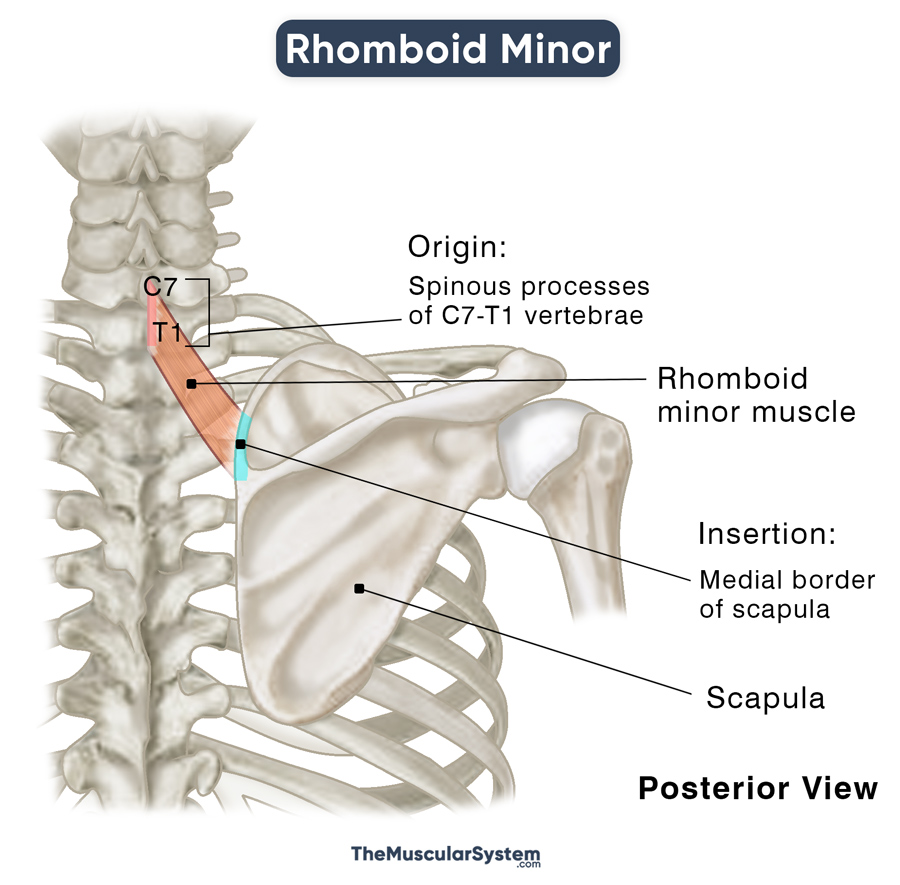Rhomboid Minor
Last updated:
28/06/2023Della Barnes, an MS Anatomy graduate, blends medical research with accessible writing, simplifying complex anatomy for a better understanding and appreciation of human anatomy.
What is Rhomboid Minor
The rhomboid minor is a small muscle located in the upper back region. The paired muscle belongs to the superficial extrinsic back muscles group with the trapezius, latissimus dorsi, rhomboid major, and levator scapulae.
It works with the rhomboid major to help with shoulder movements.
Anatomy
Location and Attachments
| Origin | The spinous processes of C7 and T1 vertebrae, and the nuchal ligament |
| Insertion | The medial border of the scapula |
Origin
The cylindrical muscle is composed of a dorsal and a ventral layer and originates from two points. The first is the nuchal ligament – a fibro-elastic membrane extending from the back of the skull (occiput) to the cervical vertebrae’s spines. The second point of origin lies in the spinous processes of the C7 and T1 vertebrae.
Insertion
From their point of origin, the muscle fibers course diagonally, outwards, and slightly downwards towards their insertion point at the scapula’s medial border, close to the base of the scapular spine. It inserts right above the point where the rhomboid major muscle inserts into the scapula. The two muscles sometimes fuse partially around this area.
The dorsal layer of the rhomboid minor inserts dorsolaterally, right below the insertion of the levator scapulae muscle, while the attachment of the ventral layer lies inferomedially.
Relations With Surrounding Muscles and Structures
Rhomboid minor overlaps the upper part of the rhomboid major muscle. Both lie deep to the trapezius muscle, which covers the rhomboid minor entirely.
Function
| Action | Retracting the scapula, and rotating it downward |
As mentioned above, both rhomboids work together to stabilize the scapula and help in shoulder movement. The muscle helps with scapular retraction, which is the scapula sliding upward and inward simultaneously along the trunk, which rotates the glenoid cavity downward, allowing you to drop your shoulders.
It also assists in keeping the scapula in place during arm and shoulder movement.
The serratus anterior muscle works as its antagonist.
Innervation
| Nerve | Dorsal scapular nerve (C4, C5) |
Blood Supply
| Artery | Dorsal scapular artery |
The Dorsal scapular artery, branching from the thyrocervical trunk, provides blood supply to this muscle. The thyrocervical trunk is a subclavian arterial branch.
References
- Rhomboid Minor Muscle: IMAIOS.com
- Rhomboid Minor (Anatomy): GPNotebook.com
- Rhomboid Minor Muscle: RadioPaedia.org
- Rhomboid Minor: TeachMeAnatomy.info
- Rhomboid Minor: Meddean.LUC.edu
Della Barnes, an MS Anatomy graduate, blends medical research with accessible writing, simplifying complex anatomy for a better understanding and appreciation of human anatomy.
- Latest Posts by Della Barnes, MS Anatomy
-
Inferior Pharyngeal Constrictor
- -
Middle Pharyngeal Constrictor
- -
Superior Pharyngeal Constrictor
- All Posts






